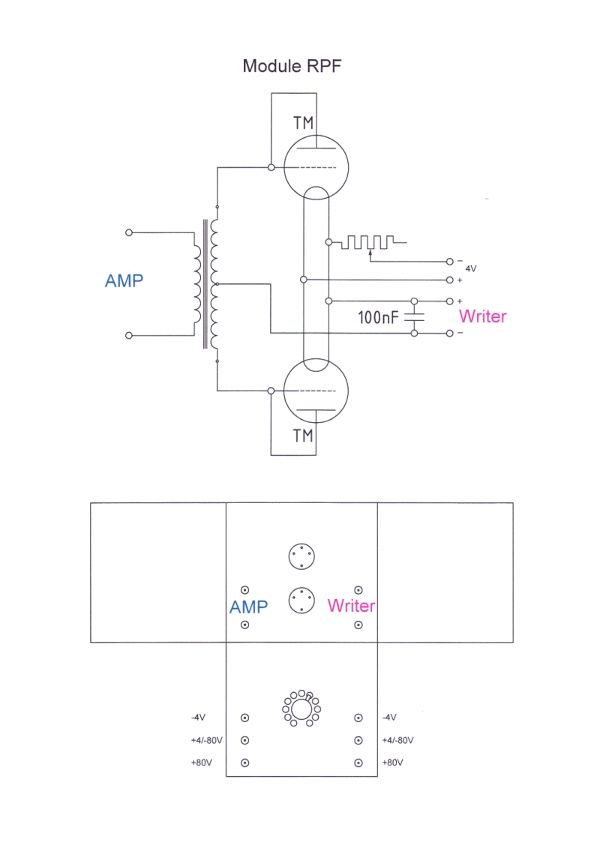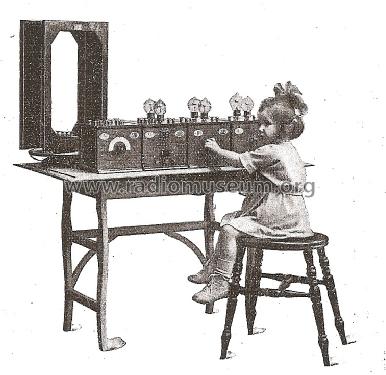Radio-Puzzle RPF
SBR Société Belge Radio-Electrique, Bruxelles
- Pays
- Belgique
- Fabricant / Marque
- SBR Société Belge Radio-Electrique, Bruxelles
- Année
- 1922

- Catégorie
- Module radio avant 1926 (pas un composant ni clavier)
- Radiomuseum.org ID
- 228393
Cliquez sur la vignette du schéma pour le demander en tant que document gratuit.
- No. de tubes
- 2
- Principe général
- Détecteur à lampe sans circuit d'accord
- Gammes d'ondes
- - sans
- Particularités
- Convertisseur
- Tension / type courant
- Piles (rechargeables ou/et sèches) / 4 Volt
- Haut-parleur
- - - Pas de sortie basse fréquence
- Matière
- Boitier en bois
- De Radiomuseum.org
- Modèle: Radio-Puzzle RPF - SBR Société Belge Radio-
- Forme
- Modèle de table boitier avec vouvercle
- Dimensions (LHP)
- 190 x 190 x 200 mm / 7.5 x 7.5 x 7.9 inch
- Remarques
-
- This unit is part of the so-called "Radio-Puzzle" which is modular in conception by placing every stage in a different module. It could be configured not only as a radio with different principles but also as telegraphy receiver and writer or as measuring equipment.
- By combination of different units, one gets a complete radio or other application.
- All connections are made with wires in clamping screws.
- The clamping screws for the filament "A" battery and the plate voltage "B" battery are placed at the same height/depth so that they can be easily interconnected. The whole powerline setup is made as a daisy chain.
- These units were initially manufactured and commercialised by S.I.B. from 1920 on before SBR took over the retailing under their own label in 1922.
- Used coils on these units are Disco-self 1922 or the preceding SIB Disco-Self 1920. They are optionally mounted on the side panels of units A, B and E. The obtainable frequency range with those coils was approximately 13kHz (23000m) to 1,75MHz (170m).
- The following modules of the Radio-Puzzle are known:
- RPA = Tuning module and optionally a crystal detector. Despite the fact that this unit doesn't need power, it has power connectors to pass along the current to the next unit;
- RPB = Tuning module with RF amplifier and detector;
- RPC = RF amplifier with regenerative feedback or an autodyne with a "Compensateur"1 and optionally a detector;
- RPD = RF amplifer with RC2 interstage coupling (autodyne amplifier together with RPC). However, this unit can be used as LF amplifier stage also;
- RPE = LF amplifier with interstage transformers;
- RPF = Tube detector (not an amplifier) to drive a morse writer or a repeater morse key. Driving power for the following relais after this unit comes from the preceding LF amplifier module (see schematic and explanation at the bottom of this page);
- RPG = Variable coupling unit for 2 disco-self coils from which 1 has fixed position on the preceding unit RPA, RPB;
- RPR = Variable coupling unit for 3 disco-self coils from which 1 has fixed position. It could be used to make a regenerative circuit by variable induction.
Alternative for TM tubes: Marconi_R
1 Compensateur: the differential variable capacitor to control the positive and negative feedback. Not a butterfly capacitor.
2 Resistor and capacitor.
- Prix de mise sur le marché
- 203.00 BFr
- Auteur
- Modèle crée par Dirk Bladt. Voir les propositions de modification pour les contributeurs supplémentaires.
- D'autres Modèles
-
Vous pourrez trouver sous ce lien 735 modèles d'appareils, 682 avec des images et 418 avec des schémas.
Tous les appareils de SBR Société Belge Radio-Electrique, Bruxelles
Contributions du forum pour ce modèle: SBR Société Belge: Radio-Puzzle RPF
Discussions: 1 | Publications: 1
Morse code pulsating tones enter the RPF (AMP), are rectified and result in a pulsating DC voltage (Writer).
This output signal may drive a relay with a pen for writing down the morse code or a relay with a morse key to convey the code (repeater key).
The power to the relay following the RPF module is provided by the preceding LF amplifier (RPE module).
Module RPF does not need a DC anode voltage supply. With the grids attached to the anodes, the tubes act as diodes and rectify the signal delivered to the anodes.
See schematic with waveform example below.


Dirk Bladt, 20.Feb.13

